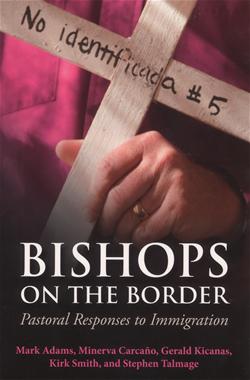REVIEWED BY DAVID LEWELLEN
 Bishops on the Border: Pastoral Responses to Immigration
Bishops on the Border: Pastoral Responses to Immigration
By Mark Adams, Minerva Carcaño, Gerald Kicanas, Kirk Smith and Stephen Talmage Morehouse Publishing, 2013 160 pages, $18
REVIEWED BY DAVID LEWELLEN
Bishops are rarely at a loss for words. Ask them to say a prayer, and they will oblige. But in 2004, Episcopal bishop Kirk Smith met a group of Guatemalans detained at the U.S.-Mexican border, in desperate straits. They had walked nearly 750 miles in search of a better life. One of their group had died. They had been arrested. They would try again to get across the border. Was Smith a priest? Would he pray for them?
"For one of the very few times in my life as a clergyperson, I literally did not know what to say," Smith writes in Bishops on the Border: Pastoral Responses to Immigration. "I felt dizzy and disoriented. This was no place for rote platitudes or sentiments. I finally croaked out something about God being with us in our suffering, but my words, at least to me, rang hollow. We shook hands all around. I was not the only one with tears."
It is a sentiment shared across denominations in Bishops on the Border, a collaboration of leading clergy from southern Arizona, where the immigration debate is personally felt. Gerald F. Kicanas, Catholic bishop of Tucson, contributes a chapter, as do Arizona representatives from the three mainline Protestant churches that use bishops — Methodist, Lutheran and Episcopal. Mark Adams, a Presbyterian mission co-worker, provides an introduction that quickly covers the history of the border and its people.
All contributors acknowledge that, as Facebook might say, it's complicated. Between the United States and Mexico, employers and workers, the affluent and the poor, law enforcement and fugitives, many interests are in conflict, and political answers are not easy.
"Our contributions are written from the heart, not the head," Smith writes in the foreword. "None of us are social scientists; rather, we are ‘chief pastors' trying to care for a part of our flocks and those outside our flocks whom we see in pain."
The pain, and the outrage, shine through in Bishops on the Border.
Every bishop has stories to tell, painting a picture that helps readers from other parts of the United States understand the issues. We learn of Mexican border towns doing a brisk business in backpacks, water bottles and other necessities for desert treks — as well as the shadowy trade of "coyotes," who will lead the desperate across the border for a steep price but abandon them at the first sign of danger. The bishops see travelers' debris in the Arizona desert, impromptu memorials where immigrants died, cardboard hovels to house hard-working vegetable pickers. They visit authorized crossing points where menacing walls are replacing chain-link fences, so that fathers in the United States can no longer see or touch their children in Mexico. They describe the grim camps for those caught in official limbo between countries. More than once, the comparison is made to
Auschwitz and Dachau.
The uniqueness of Kicanas' contribution comes from the Catholic Church's strong presence on both sides of the border. American and Mexican bishops have worked together to reduce suffering, on large and small scales.
Human suffering comes through very clearly in this book, but so does institutional responsibility, particularly in the chapters by Kicanas and Stephen Talmage, bishop of the Evangelical Lutheran Church in America, the largest and most liberal Lutheran denomination. Any church large enough to have bishops also has committees, policies, and procedures to weigh.
Every contributor describes meeting both support and furious opposition, sometimes couched in Christian terms, sometimes not. It is clear where the sympathies of these four bishops lie; but they sincerely acknowledge that the Border Patrol has a hard job and that ranchers and other inhabitants on the U.S. side face dangers of their own.
Matthew 25 runs through the book like a leitmotif, but larger solutions will take much more than individual acts of welcoming the stranger, feeding the hungry and clothing the naked.
"What would Jesus define as matters of the church?" asks Methodist bishop Minerva Carcaño. One parishioner, she says, tells her "to defend U.S. democracy." But to her, the church is not "the agent of a human political order. … we are people of the reign of God, yes, citizens of man-made political states, respectful of human laws, but above all citizens of the reign of God called to be faithful to the One alone who is sovereign."
The reign of God is one thing; the Catholic, Lutheran, Methodist and Episcopal churches are another. Within their own institutional contexts, the bishops of Arizona are doing what they can amidst a system that, intentionally or not, produces cruelty and suffering. Through programs on the ground, the churches are helping individuals. Reforming the system is another order of magnitude, but this book is their offering.
Published in 2013, Bishops on the Border reflects some hope that the United States might pass comprehensive legislation to address these dilemmas. With the hindsight of more than a year, that hope looks forlorn, and the grim realities persist. Even if laws and economies change, however, the border is likely to remain a place where ministry is urgently needed. This book, if nothing else, helps to make the issue more vivid.
DAVID LEWELLEN is a freelance writer in Glendale, Wis., and editor of Vision, the newsletter of the National Association of Catholic Chaplains.
